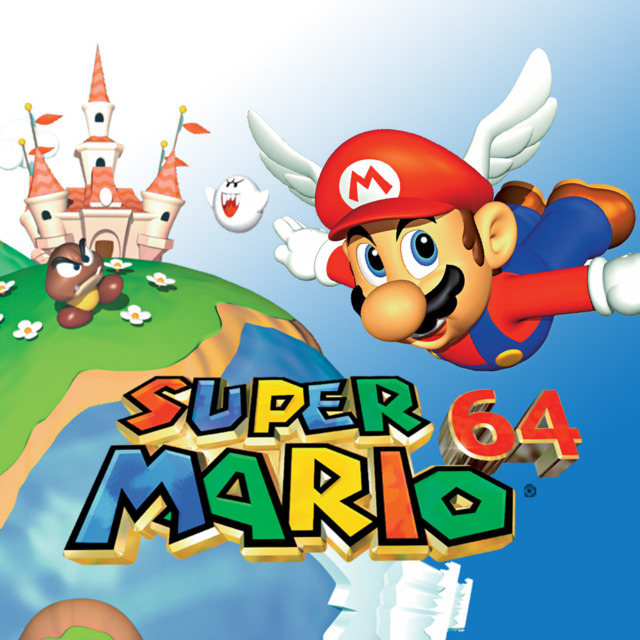Possibly the most important video game of all time
Nintendo’s 64 bit console may not have achieved the universal, record breaking success of Sony’s Playstation, but it can hardly be called a failure either. This relative success had little to do with the innumerate substandard third part games that appeared, but can be attributed to a small selection of Nintendo in-house titles that set the standards in gaming for years to come. Perhaps most high profile of these was launch title Super Mario 64. The game had to meet high expectations in light of the reputation built by the diminutive plumber during his 8 and 16 bit appearances. Thankfully, architect of the series Shigeru Miyamoto did not disappoint, as he produced certainly the greatest game a system has ever had on its release.
This review is written about Mario 64 as a new release.. away back when...
It should be made adamantly clear from the outset of this review, that Super Mario 64 is a profound piece of craftsmanship, maybe even art, and as such the following text is little more than a string of superlatives trying to explain this brilliance. As soon as the power switch on the console is moved back, the quality of this title is apparent. When beginning a game the player is presented with a malleable Mario head with which to play, a nice touch of presentation, and one that is followed up consistently throughout the game. The game proper begins within the palatial gardens surrounding Mushroom castle, the residence of maiden in distress, Princess Toadstool. Inside and around the castle a number of portals link Mario to various game worlds, most of which are represented by water like paintings on the walls. Within each of these levels, Mario must complete tasks in order to amass power stars. Regaining the stars must be accomplished if the castle is to be emancipated from the evil control of Mario’s archenemy, Bowser. This style of delivery is a variation on the maps which have set out Mario’s previous ventures, though overall the game has a familiar feel, all be it with a whole new appearance.
Mario now appears totally three-dimensional, built from polygons. But this revolution is not purely aesthetic, as Mario now has full movement within all three axis, which have to be fully explored if the player is to progress. Nintendo’s analogue stick is put to superb use, allowing Mario a large complement of moves with which to fulfil various platforming tasks. Among others, Mario can perform slides, punches, flips and stomps, all of which come into use during the games nicely varied challenges. Such control over an in-game character is unprecedented, and represents a landmark piece of programming. If any criticism can be levelled at the 3-D environment, it is the camera system which follows Mario. Occasionally it will get confused when placed against walls, but this problem is largely overcome by Nintendo’s yellow camera buttons, that allow almost total manual control of the viewpoint. While not faultless, such a system should not be criticised heavily as it represents a clear evolution in 3-D gaming.
The levels Mario explores are a little stereotypical, providing the obligatory desert, snow, and lava locations. But the variety between them is substantial, and as such any monotony is totally avoided. The standard of level design is also stunning, especially considering polygonal environments are still fairly new to game designers. Mario must manoeuvre around and over numerous fantastic obstacles if he is to complete the set challenge. Power up ‘caps’ add to this further, granting Mario special powers, including flying. The environments in Super Mario 64 are totally seamless and majestically constructed. Each level must be explored multiple times in order to gain enough power stars to defeat Bowser, and the way they adapt to facilitate these many challenges is simply stunning. ‘Wet-Dry world’ is a standout example, as a varying water level has a massive influence on which challenges can be completed. Similarly, ‘Tiny Huge Island’ sees Mario as either shrunken or enlarged, a variation which also redefines the way the level may be played. Such game design of re-exploration may be considered a cheap way to increase a game’s longevity, and may be expected to be bugged. But the sophisticated complexity of Mario 64’s levels means that such conclusions would be wholly unfair, as the multitask dynamic actually adds depth to the levels. Nintendo’s designers have quite clearly already gained a complete and comprehensive understanding of the 3-D medium. Do not assume completing Super Mario 64 is a simple case of jumping from ledge to ledge either, as while much of that will be done, keeping one step ahead of Miyamoto-San’s genius in level design is the primary challenge facing the player.
Super Mario 64 represents near perfection. Superb graphics, revolutionary controls, and a brilliant three-dimensional environment combine with exquisite level design in Mario’s latest adventure. Few games ever achieve anything close to this genial quality.
The qualities of Super Mario 64 have hardly faded since release, and every 3-D platformer since has owed a considerable dept of gratitude to this classic. Not only that but the game has not really been bettered, with even its Gamecube semi-sequel Super Mario Sunshine, being arguably inferior. The only slight fault in the game, and it was a minimal one, was the 3-D camera system. But this problem has yet to be fully overcome by anybody. As a first attempt, this was outstanding. Many games, even Nintendo’s own, are still stuck in the wake of perhaps the greatest and most revolutionary video game ever developed.

0 Comments